Cardiac Surgery: Intraoperative Methods and SSI Audit Report
VerifiedAdded on 2023/01/10
|12
|3823
|37
Report
AI Summary
This report presents a clinical audit focused on evaluating the efficacy of intraoperative methods in preventing surgical site infections (SSI) following cardiac surgery. The study investigates the use of alcohol-based chlorhexidine for skin preparation and gentamicin collagen implants, among other intraoperative techniques, aiming to improve patient outcomes and quality of life. The audit, conducted retrospectively at KEM hospital in India, analyzes data from patients who developed SSI after cardiac procedures. The report provides a background on SSI, its impact on patient mortality, and the importance of adhering to clinical guidelines and quality standards. It also details the methodology, criteria, and standards used in the audit, drawing upon guidelines from NICE. The discussion section emphasizes the significance of professional codes of conduct, the measurement and enhancement of surgical quality, and the value of various interventions in reducing SSI risk. The report concludes with recommendations for improving clinical practices and ensuring patient safety, while acknowledging limitations such as the need for larger sample sizes and robust methodologies.
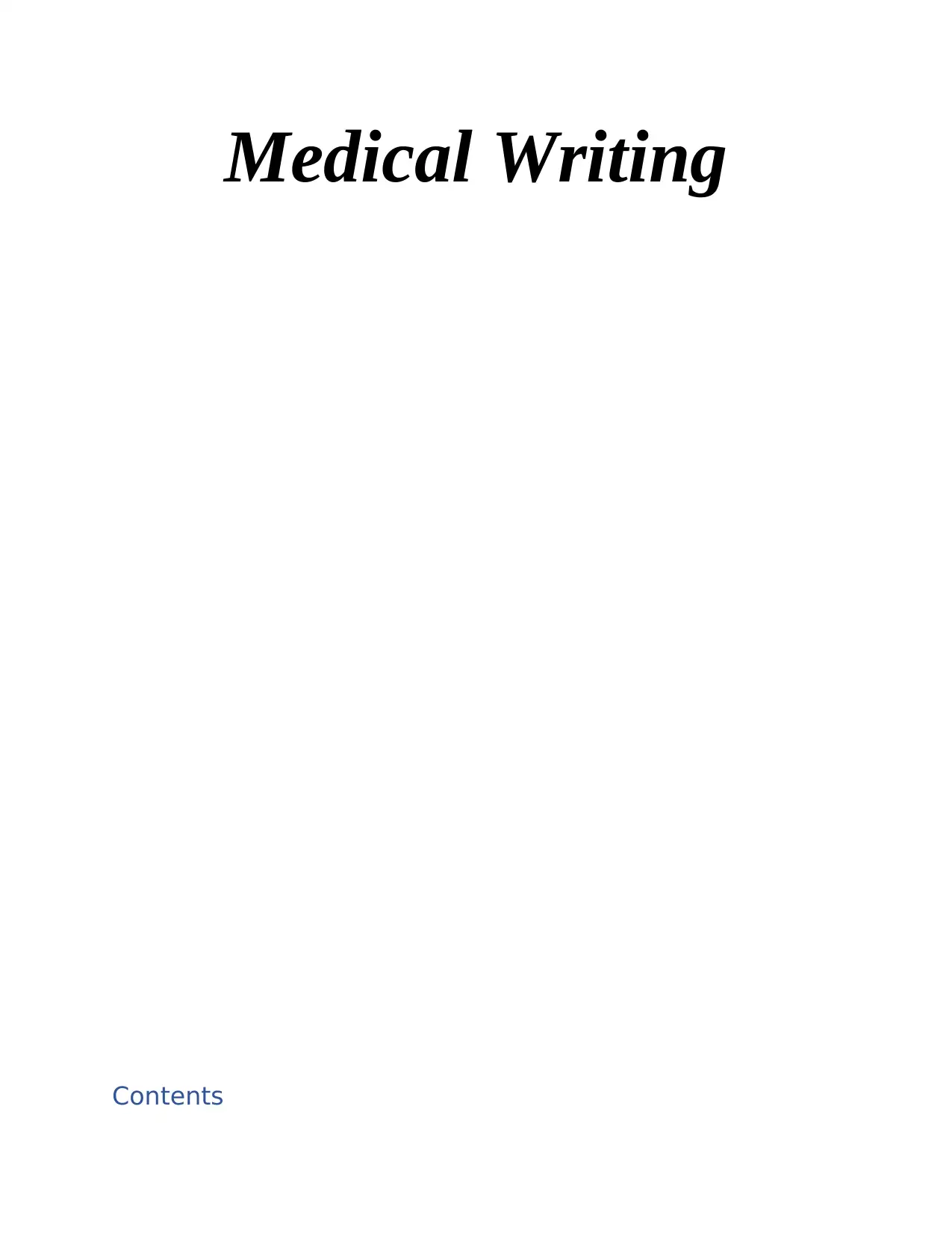
Medical Writing
Contents
Contents
Paraphrase This Document
Need a fresh take? Get an instant paraphrase of this document with our AI Paraphraser
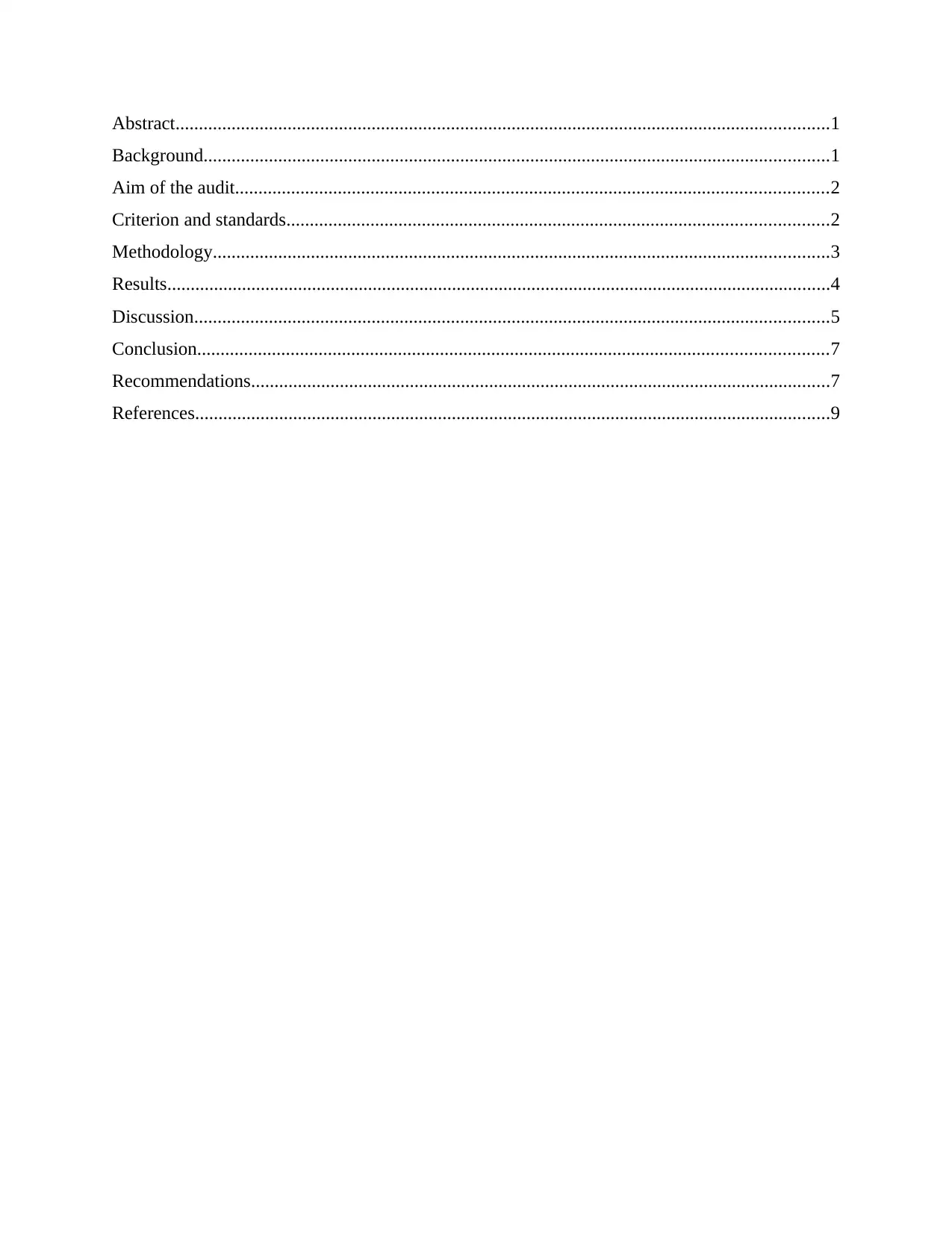
Abstract............................................................................................................................................1
Background......................................................................................................................................1
Aim of the audit...............................................................................................................................2
Criterion and standards....................................................................................................................2
Methodology....................................................................................................................................3
Results..............................................................................................................................................4
Discussion........................................................................................................................................5
Conclusion.......................................................................................................................................7
Recommendations............................................................................................................................7
References........................................................................................................................................9
Background......................................................................................................................................1
Aim of the audit...............................................................................................................................2
Criterion and standards....................................................................................................................2
Methodology....................................................................................................................................3
Results..............................................................................................................................................4
Discussion........................................................................................................................................5
Conclusion.......................................................................................................................................7
Recommendations............................................................................................................................7
References........................................................................................................................................9
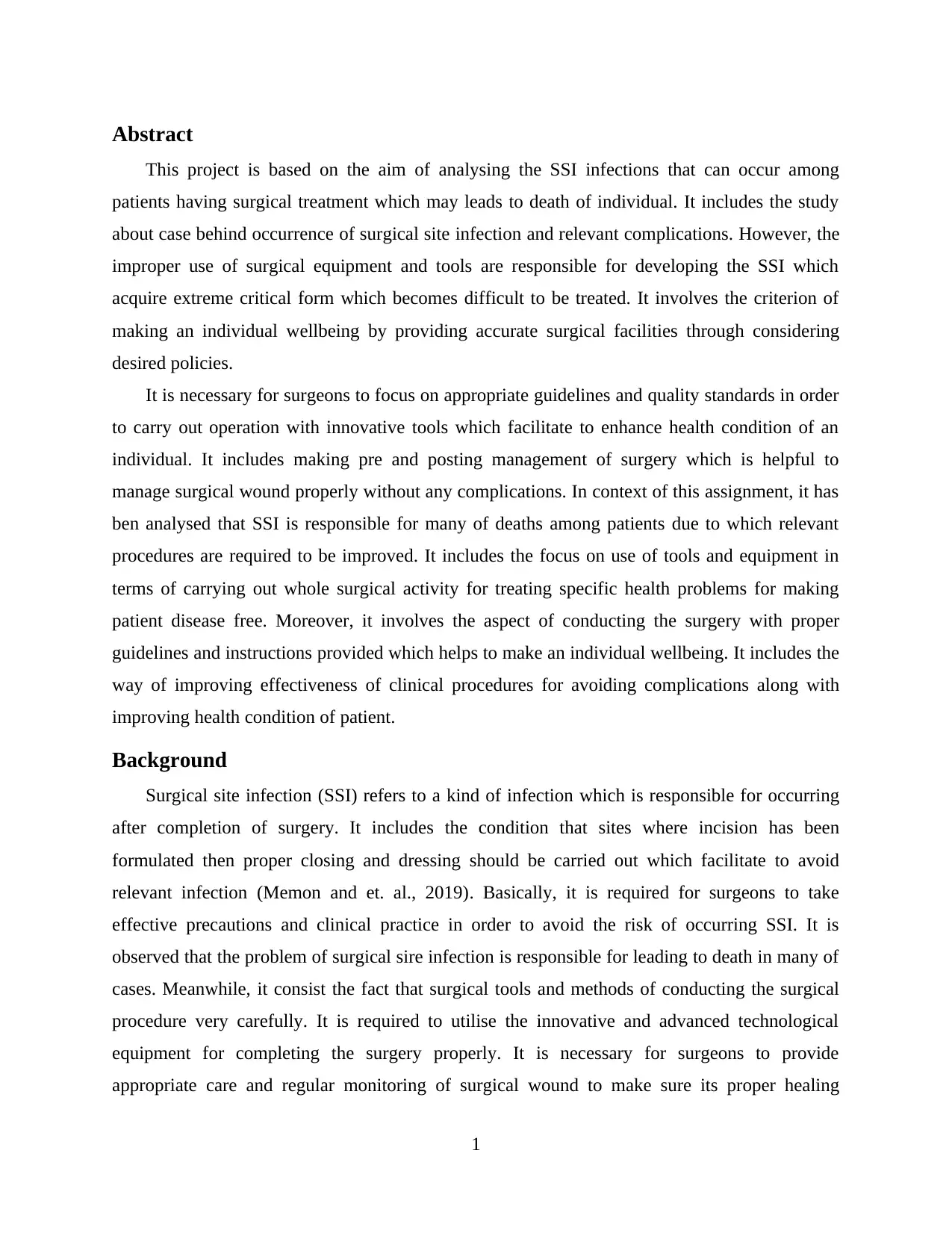
Abstract
This project is based on the aim of analysing the SSI infections that can occur among
patients having surgical treatment which may leads to death of individual. It includes the study
about case behind occurrence of surgical site infection and relevant complications. However, the
improper use of surgical equipment and tools are responsible for developing the SSI which
acquire extreme critical form which becomes difficult to be treated. It involves the criterion of
making an individual wellbeing by providing accurate surgical facilities through considering
desired policies.
It is necessary for surgeons to focus on appropriate guidelines and quality standards in order
to carry out operation with innovative tools which facilitate to enhance health condition of an
individual. It includes making pre and posting management of surgery which is helpful to
manage surgical wound properly without any complications. In context of this assignment, it has
ben analysed that SSI is responsible for many of deaths among patients due to which relevant
procedures are required to be improved. It includes the focus on use of tools and equipment in
terms of carrying out whole surgical activity for treating specific health problems for making
patient disease free. Moreover, it involves the aspect of conducting the surgery with proper
guidelines and instructions provided which helps to make an individual wellbeing. It includes the
way of improving effectiveness of clinical procedures for avoiding complications along with
improving health condition of patient.
Background
Surgical site infection (SSI) refers to a kind of infection which is responsible for occurring
after completion of surgery. It includes the condition that sites where incision has been
formulated then proper closing and dressing should be carried out which facilitate to avoid
relevant infection (Memon and et. al., 2019). Basically, it is required for surgeons to take
effective precautions and clinical practice in order to avoid the risk of occurring SSI. It is
observed that the problem of surgical sire infection is responsible for leading to death in many of
cases. Meanwhile, it consist the fact that surgical tools and methods of conducting the surgical
procedure very carefully. It is required to utilise the innovative and advanced technological
equipment for completing the surgery properly. It is necessary for surgeons to provide
appropriate care and regular monitoring of surgical wound to make sure its proper healing
1
This project is based on the aim of analysing the SSI infections that can occur among
patients having surgical treatment which may leads to death of individual. It includes the study
about case behind occurrence of surgical site infection and relevant complications. However, the
improper use of surgical equipment and tools are responsible for developing the SSI which
acquire extreme critical form which becomes difficult to be treated. It involves the criterion of
making an individual wellbeing by providing accurate surgical facilities through considering
desired policies.
It is necessary for surgeons to focus on appropriate guidelines and quality standards in order
to carry out operation with innovative tools which facilitate to enhance health condition of an
individual. It includes making pre and posting management of surgery which is helpful to
manage surgical wound properly without any complications. In context of this assignment, it has
ben analysed that SSI is responsible for many of deaths among patients due to which relevant
procedures are required to be improved. It includes the focus on use of tools and equipment in
terms of carrying out whole surgical activity for treating specific health problems for making
patient disease free. Moreover, it involves the aspect of conducting the surgery with proper
guidelines and instructions provided which helps to make an individual wellbeing. It includes the
way of improving effectiveness of clinical procedures for avoiding complications along with
improving health condition of patient.
Background
Surgical site infection (SSI) refers to a kind of infection which is responsible for occurring
after completion of surgery. It includes the condition that sites where incision has been
formulated then proper closing and dressing should be carried out which facilitate to avoid
relevant infection (Memon and et. al., 2019). Basically, it is required for surgeons to take
effective precautions and clinical practice in order to avoid the risk of occurring SSI. It is
observed that the problem of surgical sire infection is responsible for leading to death in many of
cases. Meanwhile, it consist the fact that surgical tools and methods of conducting the surgical
procedure very carefully. It is required to utilise the innovative and advanced technological
equipment for completing the surgery properly. It is necessary for surgeons to provide
appropriate care and regular monitoring of surgical wound to make sure its proper healing
1
⊘ This is a preview!⊘
Do you want full access?
Subscribe today to unlock all pages.

Trusted by 1+ million students worldwide

process by using desired mediations. In context of this project, it will focus on preventing the
incidence of surgical site infection (SSI) and to improve quality of life of the patient.
Aim of the audit
To evaluate the efficacy of intra-operative methods followed to prevent the incidence of
surgical site infection (SSI) and to improve quality of life of the patient.
Criterion and standards
According to the NICE, it has been analysed that proper clinical practices and procedures
are required to be considered in order to complete surgical process in appropriate manner (Sale
and et. al., 2019). It includes the criterion of following desired codes of conduct which will
provide support to improve the health condition of an individual. It is well known that surgery is
required to complex condition of health problem then it is very important for care professionals
to conduct the entire treatment process carefully with accurate focus. It is necessary to focus on
desired standards while providing surgical treatment which facilitate to enhance the patient
outcomes. Basically, it is observed that set clinical standards plays an important role in proper
completion of treatment process along with ensuring to avoid the chance of occurring drug errors
in healthcare settings. It is very important for surgeons and surgical team to use appropriate
equipment and tools which are helpful to avoid relevant complications in case of patient.
The NICE has been provided appropriate instructions which are required to be followed to
deliver better quality of surgical treatment respectively (Chan and et. al., 2019). It includes the
criterion of following ethical principles such as informed consent, beneficence, justice,
trustworthiness, honesty, confidentiality and many more. It includes to follow ethics which will
facilitate to deliver accurate care facilities in terms of making people feel wellbeing. Meanwhile,
it is necessary to gain essential information about actual needs of an individual who will go to
undergone surgery and supportive behaviour towards the family members of the patient during
the surgery. It involves the carrying the preoperative assessment effectively by considering
several aspects including proactive care for older people, perfusion & hydration, preoperative
nutrition, preoperative fasting, managing anaemia and management of anticoagulation
medication. However, it consist to focus on intraoperative management such as strict blood
glucose control, non-invasive cardiac output monitoring and managing systems for promoting
safety in the operation theatre. It is required to consider postoperative management & recovery
2
incidence of surgical site infection (SSI) and to improve quality of life of the patient.
Aim of the audit
To evaluate the efficacy of intra-operative methods followed to prevent the incidence of
surgical site infection (SSI) and to improve quality of life of the patient.
Criterion and standards
According to the NICE, it has been analysed that proper clinical practices and procedures
are required to be considered in order to complete surgical process in appropriate manner (Sale
and et. al., 2019). It includes the criterion of following desired codes of conduct which will
provide support to improve the health condition of an individual. It is well known that surgery is
required to complex condition of health problem then it is very important for care professionals
to conduct the entire treatment process carefully with accurate focus. It is necessary to focus on
desired standards while providing surgical treatment which facilitate to enhance the patient
outcomes. Basically, it is observed that set clinical standards plays an important role in proper
completion of treatment process along with ensuring to avoid the chance of occurring drug errors
in healthcare settings. It is very important for surgeons and surgical team to use appropriate
equipment and tools which are helpful to avoid relevant complications in case of patient.
The NICE has been provided appropriate instructions which are required to be followed to
deliver better quality of surgical treatment respectively (Chan and et. al., 2019). It includes the
criterion of following ethical principles such as informed consent, beneficence, justice,
trustworthiness, honesty, confidentiality and many more. It includes to follow ethics which will
facilitate to deliver accurate care facilities in terms of making people feel wellbeing. Meanwhile,
it is necessary to gain essential information about actual needs of an individual who will go to
undergone surgery and supportive behaviour towards the family members of the patient during
the surgery. It involves the carrying the preoperative assessment effectively by considering
several aspects including proactive care for older people, perfusion & hydration, preoperative
nutrition, preoperative fasting, managing anaemia and management of anticoagulation
medication. However, it consist to focus on intraoperative management such as strict blood
glucose control, non-invasive cardiac output monitoring and managing systems for promoting
safety in the operation theatre. It is required to consider postoperative management & recovery
2
Paraphrase This Document
Need a fresh take? Get an instant paraphrase of this document with our AI Paraphraser
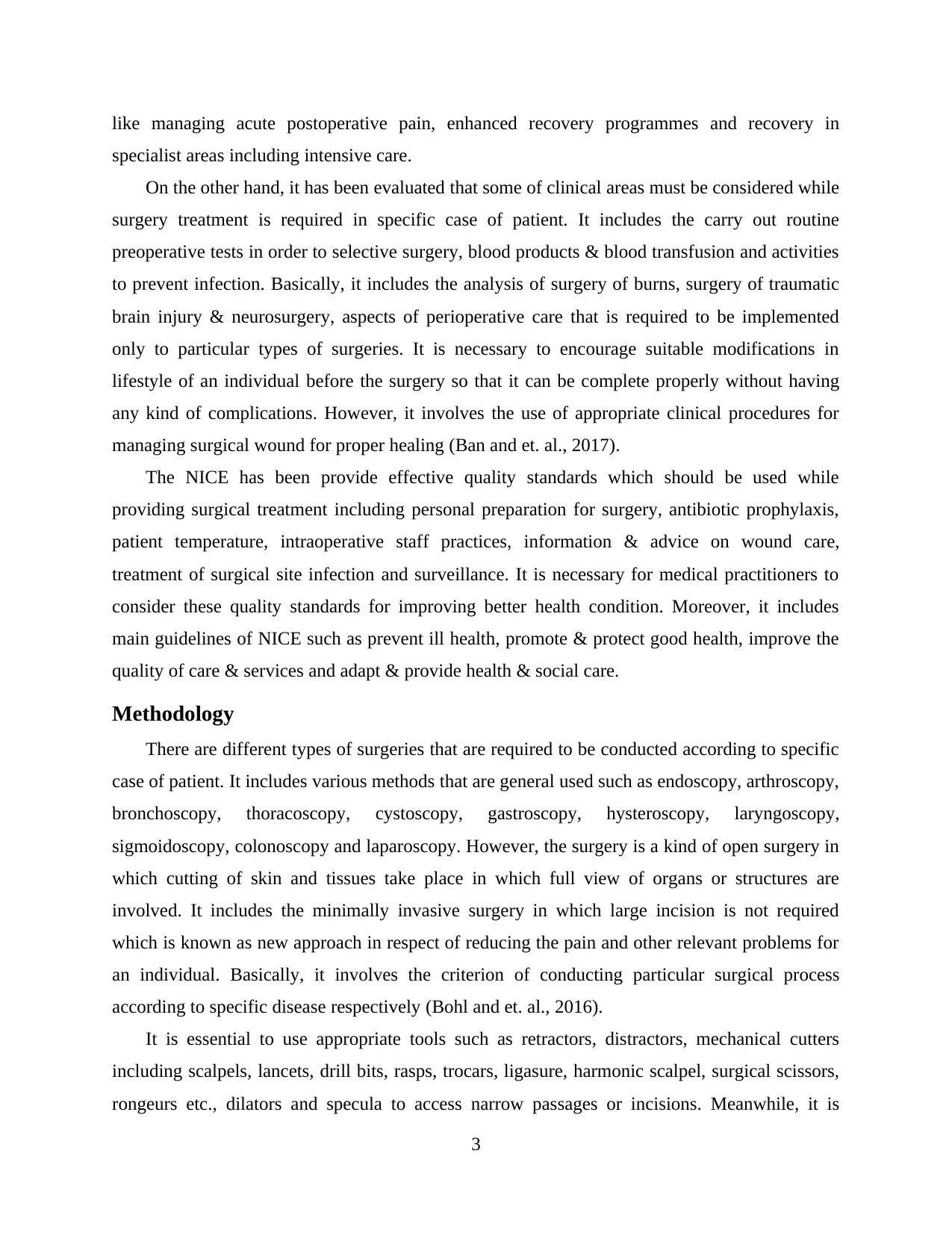
like managing acute postoperative pain, enhanced recovery programmes and recovery in
specialist areas including intensive care.
On the other hand, it has been evaluated that some of clinical areas must be considered while
surgery treatment is required in specific case of patient. It includes the carry out routine
preoperative tests in order to selective surgery, blood products & blood transfusion and activities
to prevent infection. Basically, it includes the analysis of surgery of burns, surgery of traumatic
brain injury & neurosurgery, aspects of perioperative care that is required to be implemented
only to particular types of surgeries. It is necessary to encourage suitable modifications in
lifestyle of an individual before the surgery so that it can be complete properly without having
any kind of complications. However, it involves the use of appropriate clinical procedures for
managing surgical wound for proper healing (Ban and et. al., 2017).
The NICE has been provide effective quality standards which should be used while
providing surgical treatment including personal preparation for surgery, antibiotic prophylaxis,
patient temperature, intraoperative staff practices, information & advice on wound care,
treatment of surgical site infection and surveillance. It is necessary for medical practitioners to
consider these quality standards for improving better health condition. Moreover, it includes
main guidelines of NICE such as prevent ill health, promote & protect good health, improve the
quality of care & services and adapt & provide health & social care.
Methodology
There are different types of surgeries that are required to be conducted according to specific
case of patient. It includes various methods that are general used such as endoscopy, arthroscopy,
bronchoscopy, thoracoscopy, cystoscopy, gastroscopy, hysteroscopy, laryngoscopy,
sigmoidoscopy, colonoscopy and laparoscopy. However, the surgery is a kind of open surgery in
which cutting of skin and tissues take place in which full view of organs or structures are
involved. It includes the minimally invasive surgery in which large incision is not required
which is known as new approach in respect of reducing the pain and other relevant problems for
an individual. Basically, it involves the criterion of conducting particular surgical process
according to specific disease respectively (Bohl and et. al., 2016).
It is essential to use appropriate tools such as retractors, distractors, mechanical cutters
including scalpels, lancets, drill bits, rasps, trocars, ligasure, harmonic scalpel, surgical scissors,
rongeurs etc., dilators and specula to access narrow passages or incisions. Meanwhile, it is
3
specialist areas including intensive care.
On the other hand, it has been evaluated that some of clinical areas must be considered while
surgery treatment is required in specific case of patient. It includes the carry out routine
preoperative tests in order to selective surgery, blood products & blood transfusion and activities
to prevent infection. Basically, it includes the analysis of surgery of burns, surgery of traumatic
brain injury & neurosurgery, aspects of perioperative care that is required to be implemented
only to particular types of surgeries. It is necessary to encourage suitable modifications in
lifestyle of an individual before the surgery so that it can be complete properly without having
any kind of complications. However, it involves the use of appropriate clinical procedures for
managing surgical wound for proper healing (Ban and et. al., 2017).
The NICE has been provide effective quality standards which should be used while
providing surgical treatment including personal preparation for surgery, antibiotic prophylaxis,
patient temperature, intraoperative staff practices, information & advice on wound care,
treatment of surgical site infection and surveillance. It is necessary for medical practitioners to
consider these quality standards for improving better health condition. Moreover, it includes
main guidelines of NICE such as prevent ill health, promote & protect good health, improve the
quality of care & services and adapt & provide health & social care.
Methodology
There are different types of surgeries that are required to be conducted according to specific
case of patient. It includes various methods that are general used such as endoscopy, arthroscopy,
bronchoscopy, thoracoscopy, cystoscopy, gastroscopy, hysteroscopy, laryngoscopy,
sigmoidoscopy, colonoscopy and laparoscopy. However, the surgery is a kind of open surgery in
which cutting of skin and tissues take place in which full view of organs or structures are
involved. It includes the minimally invasive surgery in which large incision is not required
which is known as new approach in respect of reducing the pain and other relevant problems for
an individual. Basically, it involves the criterion of conducting particular surgical process
according to specific disease respectively (Bohl and et. al., 2016).
It is essential to use appropriate tools such as retractors, distractors, mechanical cutters
including scalpels, lancets, drill bits, rasps, trocars, ligasure, harmonic scalpel, surgical scissors,
rongeurs etc., dilators and specula to access narrow passages or incisions. Meanwhile, it is
3

necessary to make an effective set of instruments to be sued which are safe and appropriate for
patient in order to complete the operation process in proper manner (Leaper and Edmiston,
2017). The surgical instruments can be categorised into several categorise like cutting
instruments, grasping or holding equipment and retractors. It includes cutting tools like scissors,
surgical blades, knives & scalpels; grasping tools including haemostatic forceps & tissues
forceps and retractors involves Gelpi & Weitlaner. Moreover, it consist the many of other
instruments such as clamps, vessel clips, bulldog clamps, drills, sutures, binocular loupes, biopsy
punches and so on.
On the other hand, various types of cutting instruments like fine tip scissors like Vannas,
Castroviejos & McPhersons which are ideally used in surgery. It includes the requirement of
curve tipped scissors and scissors with heavier construction like Metzenbaun, Mayo and
SuperCut scissors (Kim and et. al., 2017). Basically, it includes the use of scissors with tungsten,
spring scissor, sapphire blades to make incisions on surgical site. It involves the geasping tools
like reverse forceps, ceramic tipped forceps, straight tips on forceps including Kelly-rankin
hemostats, Rochester-oschner hemostats, Hartman mosquito forceps, halstead mosquito forceps
etc. It is required to consider the thumb forceps for Adson tissue and Bonn tissue along with iris
dressing forceps, iris tissue forceps as well as graefe forceps (Morrison and et. al., 2016).
Meanwhile, it has been evaluated that retractors are use like hand retractors, self-retaining
retractor and wire retractor. It is essential to utilise the appropriate set of surgical tools and
equipment for specific surgery for improving health condition of patient by treating their
respective disease accordingly.
In addition this this, it has been identified that surgical instruments are required to get
sterilised properly to reduce risk of occurring infections of surgical site. It is not sufficient to
carry out the surgical process in effective manner but the management practices before and after
the surgery to manage the entire situation. It is very important for surgeons and nursing staff in
respect of managing the post-operative care practices for improving condition of an individual. It
consist the aspect of managing wound or surgical site for healing easily and avoid relevant
infections (Johnson and et. al., 2016).
Results
Considering the above data, it has been analysed that professional codes of conduct should
be used by care practitioners for improving the condition of an individual. It is necessary for
4
patient in order to complete the operation process in proper manner (Leaper and Edmiston,
2017). The surgical instruments can be categorised into several categorise like cutting
instruments, grasping or holding equipment and retractors. It includes cutting tools like scissors,
surgical blades, knives & scalpels; grasping tools including haemostatic forceps & tissues
forceps and retractors involves Gelpi & Weitlaner. Moreover, it consist the many of other
instruments such as clamps, vessel clips, bulldog clamps, drills, sutures, binocular loupes, biopsy
punches and so on.
On the other hand, various types of cutting instruments like fine tip scissors like Vannas,
Castroviejos & McPhersons which are ideally used in surgery. It includes the requirement of
curve tipped scissors and scissors with heavier construction like Metzenbaun, Mayo and
SuperCut scissors (Kim and et. al., 2017). Basically, it includes the use of scissors with tungsten,
spring scissor, sapphire blades to make incisions on surgical site. It involves the geasping tools
like reverse forceps, ceramic tipped forceps, straight tips on forceps including Kelly-rankin
hemostats, Rochester-oschner hemostats, Hartman mosquito forceps, halstead mosquito forceps
etc. It is required to consider the thumb forceps for Adson tissue and Bonn tissue along with iris
dressing forceps, iris tissue forceps as well as graefe forceps (Morrison and et. al., 2016).
Meanwhile, it has been evaluated that retractors are use like hand retractors, self-retaining
retractor and wire retractor. It is essential to utilise the appropriate set of surgical tools and
equipment for specific surgery for improving health condition of patient by treating their
respective disease accordingly.
In addition this this, it has been identified that surgical instruments are required to get
sterilised properly to reduce risk of occurring infections of surgical site. It is not sufficient to
carry out the surgical process in effective manner but the management practices before and after
the surgery to manage the entire situation. It is very important for surgeons and nursing staff in
respect of managing the post-operative care practices for improving condition of an individual. It
consist the aspect of managing wound or surgical site for healing easily and avoid relevant
infections (Johnson and et. al., 2016).
Results
Considering the above data, it has been analysed that professional codes of conduct should
be used by care practitioners for improving the condition of an individual. It is necessary for
4
⊘ This is a preview!⊘
Do you want full access?
Subscribe today to unlock all pages.

Trusted by 1+ million students worldwide
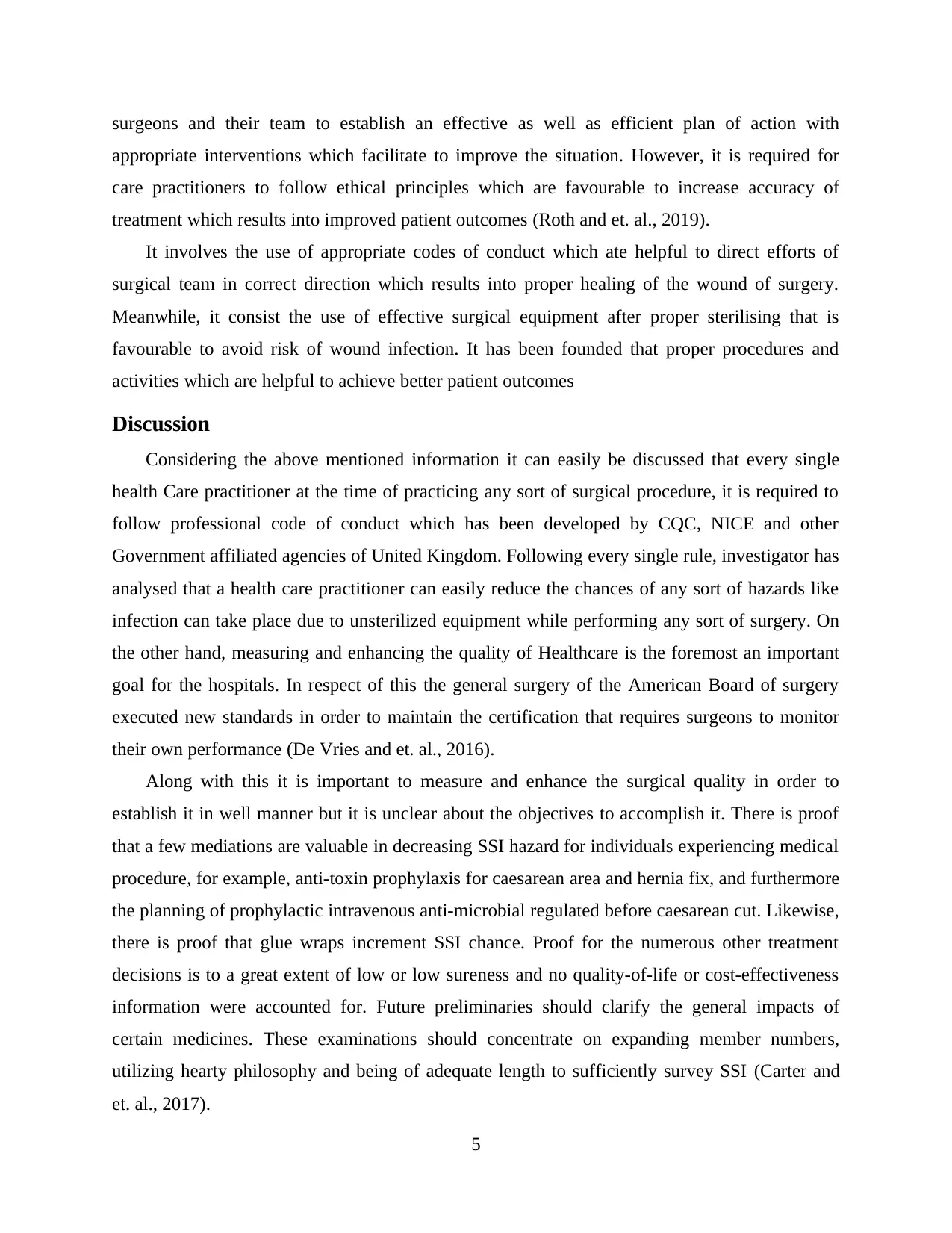
surgeons and their team to establish an effective as well as efficient plan of action with
appropriate interventions which facilitate to improve the situation. However, it is required for
care practitioners to follow ethical principles which are favourable to increase accuracy of
treatment which results into improved patient outcomes (Roth and et. al., 2019).
It involves the use of appropriate codes of conduct which ate helpful to direct efforts of
surgical team in correct direction which results into proper healing of the wound of surgery.
Meanwhile, it consist the use of effective surgical equipment after proper sterilising that is
favourable to avoid risk of wound infection. It has been founded that proper procedures and
activities which are helpful to achieve better patient outcomes
Discussion
Considering the above mentioned information it can easily be discussed that every single
health Care practitioner at the time of practicing any sort of surgical procedure, it is required to
follow professional code of conduct which has been developed by CQC, NICE and other
Government affiliated agencies of United Kingdom. Following every single rule, investigator has
analysed that a health care practitioner can easily reduce the chances of any sort of hazards like
infection can take place due to unsterilized equipment while performing any sort of surgery. On
the other hand, measuring and enhancing the quality of Healthcare is the foremost an important
goal for the hospitals. In respect of this the general surgery of the American Board of surgery
executed new standards in order to maintain the certification that requires surgeons to monitor
their own performance (De Vries and et. al., 2016).
Along with this it is important to measure and enhance the surgical quality in order to
establish it in well manner but it is unclear about the objectives to accomplish it. There is proof
that a few mediations are valuable in decreasing SSI hazard for individuals experiencing medical
procedure, for example, anti-toxin prophylaxis for caesarean area and hernia fix, and furthermore
the planning of prophylactic intravenous anti-microbial regulated before caesarean cut. Likewise,
there is proof that glue wraps increment SSI chance. Proof for the numerous other treatment
decisions is to a great extent of low or low sureness and no quality‐of‐life or cost‐effectiveness
information were accounted for. Future preliminaries should clarify the general impacts of
certain medicines. These examinations should concentrate on expanding member numbers,
utilizing hearty philosophy and being of adequate length to sufficiently survey SSI (Carter and
et. al., 2017).
5
appropriate interventions which facilitate to improve the situation. However, it is required for
care practitioners to follow ethical principles which are favourable to increase accuracy of
treatment which results into improved patient outcomes (Roth and et. al., 2019).
It involves the use of appropriate codes of conduct which ate helpful to direct efforts of
surgical team in correct direction which results into proper healing of the wound of surgery.
Meanwhile, it consist the use of effective surgical equipment after proper sterilising that is
favourable to avoid risk of wound infection. It has been founded that proper procedures and
activities which are helpful to achieve better patient outcomes
Discussion
Considering the above mentioned information it can easily be discussed that every single
health Care practitioner at the time of practicing any sort of surgical procedure, it is required to
follow professional code of conduct which has been developed by CQC, NICE and other
Government affiliated agencies of United Kingdom. Following every single rule, investigator has
analysed that a health care practitioner can easily reduce the chances of any sort of hazards like
infection can take place due to unsterilized equipment while performing any sort of surgery. On
the other hand, measuring and enhancing the quality of Healthcare is the foremost an important
goal for the hospitals. In respect of this the general surgery of the American Board of surgery
executed new standards in order to maintain the certification that requires surgeons to monitor
their own performance (De Vries and et. al., 2016).
Along with this it is important to measure and enhance the surgical quality in order to
establish it in well manner but it is unclear about the objectives to accomplish it. There is proof
that a few mediations are valuable in decreasing SSI hazard for individuals experiencing medical
procedure, for example, anti-toxin prophylaxis for caesarean area and hernia fix, and furthermore
the planning of prophylactic intravenous anti-microbial regulated before caesarean cut. Likewise,
there is proof that glue wraps increment SSI chance. Proof for the numerous other treatment
decisions is to a great extent of low or low sureness and no quality‐of‐life or cost‐effectiveness
information were accounted for. Future preliminaries should clarify the general impacts of
certain medicines. These examinations should concentrate on expanding member numbers,
utilizing hearty philosophy and being of adequate length to sufficiently survey SSI (Carter and
et. al., 2017).
5
Paraphrase This Document
Need a fresh take? Get an instant paraphrase of this document with our AI Paraphraser
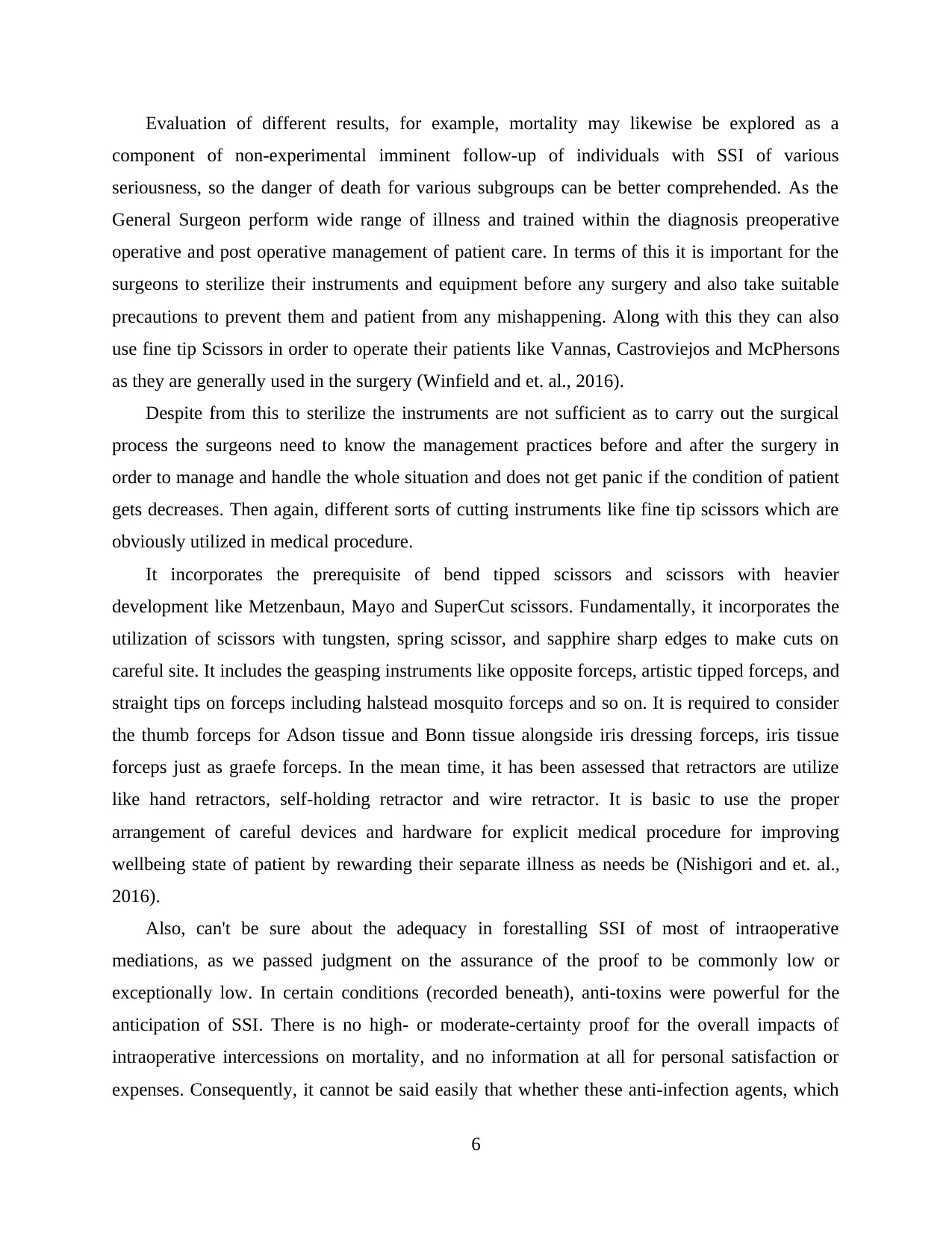
Evaluation of different results, for example, mortality may likewise be explored as a
component of non‐experimental imminent follow‐up of individuals with SSI of various
seriousness, so the danger of death for various subgroups can be better comprehended. As the
General Surgeon perform wide range of illness and trained within the diagnosis preoperative
operative and post operative management of patient care. In terms of this it is important for the
surgeons to sterilize their instruments and equipment before any surgery and also take suitable
precautions to prevent them and patient from any mishappening. Along with this they can also
use fine tip Scissors in order to operate their patients like Vannas, Castroviejos and McPhersons
as they are generally used in the surgery (Winfield and et. al., 2016).
Despite from this to sterilize the instruments are not sufficient as to carry out the surgical
process the surgeons need to know the management practices before and after the surgery in
order to manage and handle the whole situation and does not get panic if the condition of patient
gets decreases. Then again, different sorts of cutting instruments like fine tip scissors which are
obviously utilized in medical procedure.
It incorporates the prerequisite of bend tipped scissors and scissors with heavier
development like Metzenbaun, Mayo and SuperCut scissors. Fundamentally, it incorporates the
utilization of scissors with tungsten, spring scissor, and sapphire sharp edges to make cuts on
careful site. It includes the geasping instruments like opposite forceps, artistic tipped forceps, and
straight tips on forceps including halstead mosquito forceps and so on. It is required to consider
the thumb forceps for Adson tissue and Bonn tissue alongside iris dressing forceps, iris tissue
forceps just as graefe forceps. In the mean time, it has been assessed that retractors are utilize
like hand retractors, self-holding retractor and wire retractor. It is basic to use the proper
arrangement of careful devices and hardware for explicit medical procedure for improving
wellbeing state of patient by rewarding their separate illness as needs be (Nishigori and et. al.,
2016).
Also, can't be sure about the adequacy in forestalling SSI of most of intraoperative
mediations, as we passed judgment on the assurance of the proof to be commonly low or
exceptionally low. In certain conditions (recorded beneath), anti-toxins were powerful for the
anticipation of SSI. There is no high‐ or moderate‐certainty proof for the overall impacts of
intraoperative intercessions on mortality, and no information at all for personal satisfaction or
expenses. Consequently, it cannot be said easily that whether these anti-infection agents, which
6
component of non‐experimental imminent follow‐up of individuals with SSI of various
seriousness, so the danger of death for various subgroups can be better comprehended. As the
General Surgeon perform wide range of illness and trained within the diagnosis preoperative
operative and post operative management of patient care. In terms of this it is important for the
surgeons to sterilize their instruments and equipment before any surgery and also take suitable
precautions to prevent them and patient from any mishappening. Along with this they can also
use fine tip Scissors in order to operate their patients like Vannas, Castroviejos and McPhersons
as they are generally used in the surgery (Winfield and et. al., 2016).
Despite from this to sterilize the instruments are not sufficient as to carry out the surgical
process the surgeons need to know the management practices before and after the surgery in
order to manage and handle the whole situation and does not get panic if the condition of patient
gets decreases. Then again, different sorts of cutting instruments like fine tip scissors which are
obviously utilized in medical procedure.
It incorporates the prerequisite of bend tipped scissors and scissors with heavier
development like Metzenbaun, Mayo and SuperCut scissors. Fundamentally, it incorporates the
utilization of scissors with tungsten, spring scissor, and sapphire sharp edges to make cuts on
careful site. It includes the geasping instruments like opposite forceps, artistic tipped forceps, and
straight tips on forceps including halstead mosquito forceps and so on. It is required to consider
the thumb forceps for Adson tissue and Bonn tissue alongside iris dressing forceps, iris tissue
forceps just as graefe forceps. In the mean time, it has been assessed that retractors are utilize
like hand retractors, self-holding retractor and wire retractor. It is basic to use the proper
arrangement of careful devices and hardware for explicit medical procedure for improving
wellbeing state of patient by rewarding their separate illness as needs be (Nishigori and et. al.,
2016).
Also, can't be sure about the adequacy in forestalling SSI of most of intraoperative
mediations, as we passed judgment on the assurance of the proof to be commonly low or
exceptionally low. In certain conditions (recorded beneath), anti-toxins were powerful for the
anticipation of SSI. There is no high‐ or moderate‐certainty proof for the overall impacts of
intraoperative intercessions on mortality, and no information at all for personal satisfaction or
expenses. Consequently, it cannot be said easily that whether these anti-infection agents, which
6
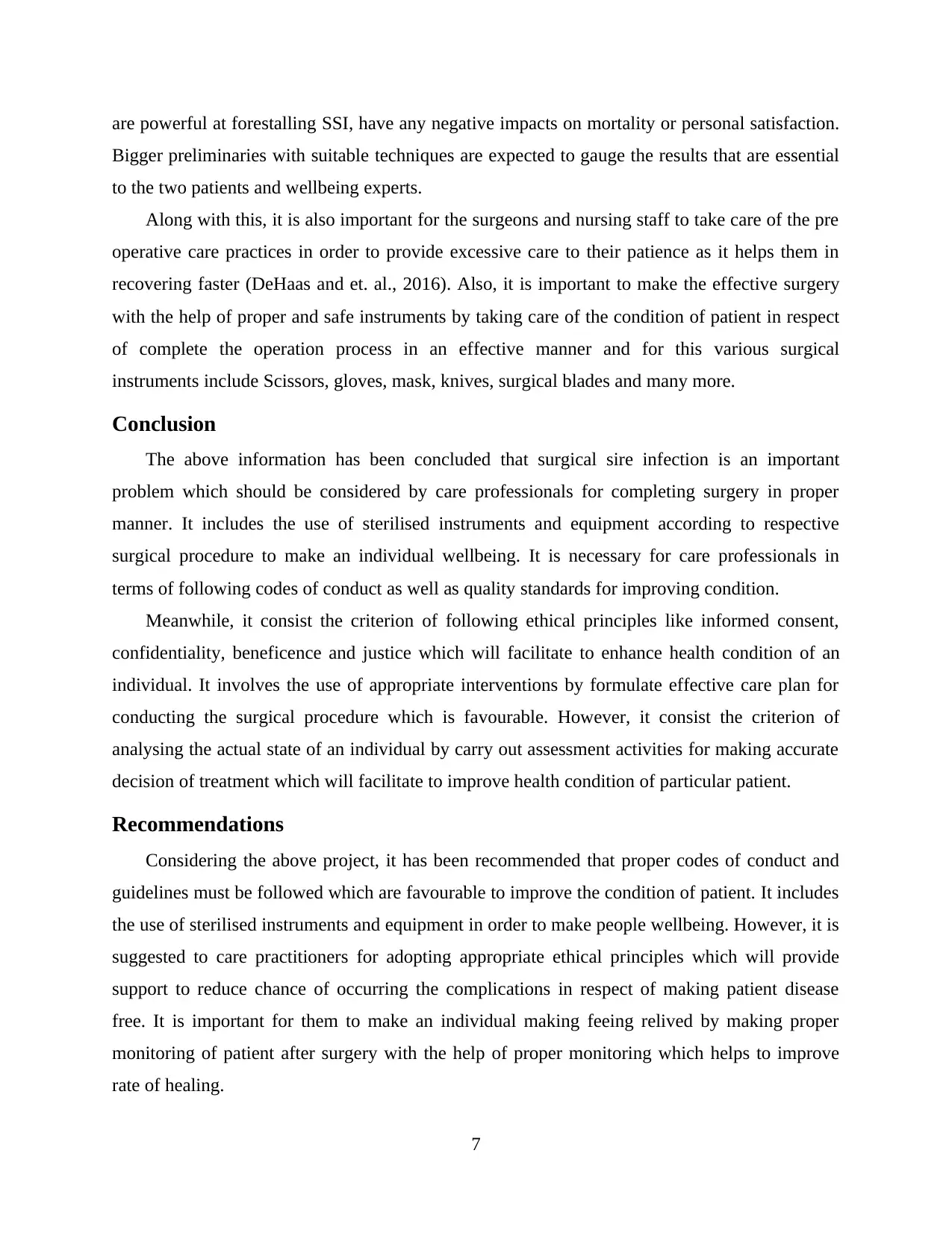
are powerful at forestalling SSI, have any negative impacts on mortality or personal satisfaction.
Bigger preliminaries with suitable techniques are expected to gauge the results that are essential
to the two patients and wellbeing experts.
Along with this, it is also important for the surgeons and nursing staff to take care of the pre
operative care practices in order to provide excessive care to their patience as it helps them in
recovering faster (DeHaas and et. al., 2016). Also, it is important to make the effective surgery
with the help of proper and safe instruments by taking care of the condition of patient in respect
of complete the operation process in an effective manner and for this various surgical
instruments include Scissors, gloves, mask, knives, surgical blades and many more.
Conclusion
The above information has been concluded that surgical sire infection is an important
problem which should be considered by care professionals for completing surgery in proper
manner. It includes the use of sterilised instruments and equipment according to respective
surgical procedure to make an individual wellbeing. It is necessary for care professionals in
terms of following codes of conduct as well as quality standards for improving condition.
Meanwhile, it consist the criterion of following ethical principles like informed consent,
confidentiality, beneficence and justice which will facilitate to enhance health condition of an
individual. It involves the use of appropriate interventions by formulate effective care plan for
conducting the surgical procedure which is favourable. However, it consist the criterion of
analysing the actual state of an individual by carry out assessment activities for making accurate
decision of treatment which will facilitate to improve health condition of particular patient.
Recommendations
Considering the above project, it has been recommended that proper codes of conduct and
guidelines must be followed which are favourable to improve the condition of patient. It includes
the use of sterilised instruments and equipment in order to make people wellbeing. However, it is
suggested to care practitioners for adopting appropriate ethical principles which will provide
support to reduce chance of occurring the complications in respect of making patient disease
free. It is important for them to make an individual making feeing relived by making proper
monitoring of patient after surgery with the help of proper monitoring which helps to improve
rate of healing.
7
Bigger preliminaries with suitable techniques are expected to gauge the results that are essential
to the two patients and wellbeing experts.
Along with this, it is also important for the surgeons and nursing staff to take care of the pre
operative care practices in order to provide excessive care to their patience as it helps them in
recovering faster (DeHaas and et. al., 2016). Also, it is important to make the effective surgery
with the help of proper and safe instruments by taking care of the condition of patient in respect
of complete the operation process in an effective manner and for this various surgical
instruments include Scissors, gloves, mask, knives, surgical blades and many more.
Conclusion
The above information has been concluded that surgical sire infection is an important
problem which should be considered by care professionals for completing surgery in proper
manner. It includes the use of sterilised instruments and equipment according to respective
surgical procedure to make an individual wellbeing. It is necessary for care professionals in
terms of following codes of conduct as well as quality standards for improving condition.
Meanwhile, it consist the criterion of following ethical principles like informed consent,
confidentiality, beneficence and justice which will facilitate to enhance health condition of an
individual. It involves the use of appropriate interventions by formulate effective care plan for
conducting the surgical procedure which is favourable. However, it consist the criterion of
analysing the actual state of an individual by carry out assessment activities for making accurate
decision of treatment which will facilitate to improve health condition of particular patient.
Recommendations
Considering the above project, it has been recommended that proper codes of conduct and
guidelines must be followed which are favourable to improve the condition of patient. It includes
the use of sterilised instruments and equipment in order to make people wellbeing. However, it is
suggested to care practitioners for adopting appropriate ethical principles which will provide
support to reduce chance of occurring the complications in respect of making patient disease
free. It is important for them to make an individual making feeing relived by making proper
monitoring of patient after surgery with the help of proper monitoring which helps to improve
rate of healing.
7
⊘ This is a preview!⊘
Do you want full access?
Subscribe today to unlock all pages.

Trusted by 1+ million students worldwide
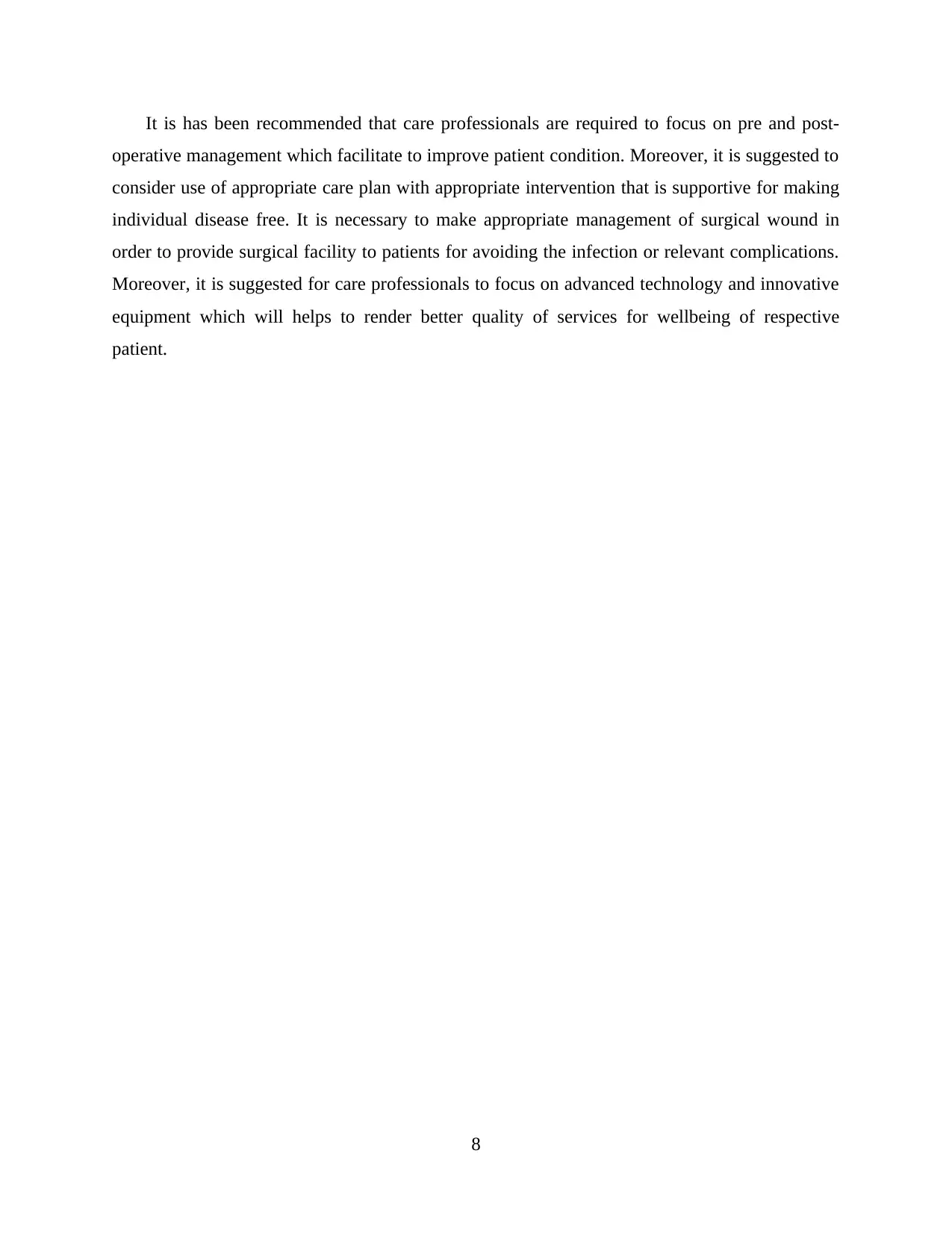
It is has been recommended that care professionals are required to focus on pre and post-
operative management which facilitate to improve patient condition. Moreover, it is suggested to
consider use of appropriate care plan with appropriate intervention that is supportive for making
individual disease free. It is necessary to make appropriate management of surgical wound in
order to provide surgical facility to patients for avoiding the infection or relevant complications.
Moreover, it is suggested for care professionals to focus on advanced technology and innovative
equipment which will helps to render better quality of services for wellbeing of respective
patient.
8
operative management which facilitate to improve patient condition. Moreover, it is suggested to
consider use of appropriate care plan with appropriate intervention that is supportive for making
individual disease free. It is necessary to make appropriate management of surgical wound in
order to provide surgical facility to patients for avoiding the infection or relevant complications.
Moreover, it is suggested for care professionals to focus on advanced technology and innovative
equipment which will helps to render better quality of services for wellbeing of respective
patient.
8
Paraphrase This Document
Need a fresh take? Get an instant paraphrase of this document with our AI Paraphraser
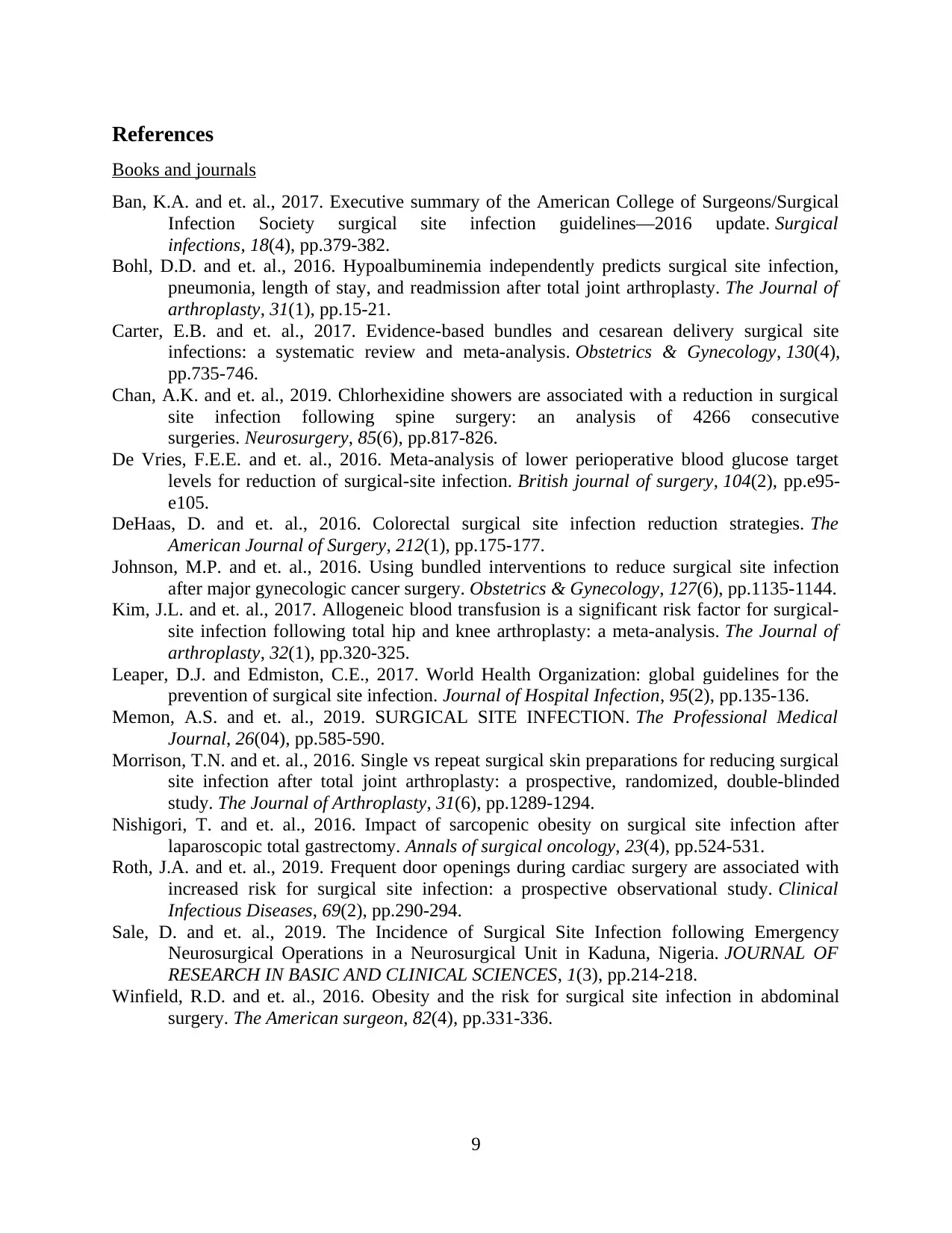
References
Books and journals
Ban, K.A. and et. al., 2017. Executive summary of the American College of Surgeons/Surgical
Infection Society surgical site infection guidelines—2016 update. Surgical
infections, 18(4), pp.379-382.
Bohl, D.D. and et. al., 2016. Hypoalbuminemia independently predicts surgical site infection,
pneumonia, length of stay, and readmission after total joint arthroplasty. The Journal of
arthroplasty, 31(1), pp.15-21.
Carter, E.B. and et. al., 2017. Evidence-based bundles and cesarean delivery surgical site
infections: a systematic review and meta-analysis. Obstetrics & Gynecology, 130(4),
pp.735-746.
Chan, A.K. and et. al., 2019. Chlorhexidine showers are associated with a reduction in surgical
site infection following spine surgery: an analysis of 4266 consecutive
surgeries. Neurosurgery, 85(6), pp.817-826.
De Vries, F.E.E. and et. al., 2016. Meta-analysis of lower perioperative blood glucose target
levels for reduction of surgical-site infection. British journal of surgery, 104(2), pp.e95-
e105.
DeHaas, D. and et. al., 2016. Colorectal surgical site infection reduction strategies. The
American Journal of Surgery, 212(1), pp.175-177.
Johnson, M.P. and et. al., 2016. Using bundled interventions to reduce surgical site infection
after major gynecologic cancer surgery. Obstetrics & Gynecology, 127(6), pp.1135-1144.
Kim, J.L. and et. al., 2017. Allogeneic blood transfusion is a significant risk factor for surgical-
site infection following total hip and knee arthroplasty: a meta-analysis. The Journal of
arthroplasty, 32(1), pp.320-325.
Leaper, D.J. and Edmiston, C.E., 2017. World Health Organization: global guidelines for the
prevention of surgical site infection. Journal of Hospital Infection, 95(2), pp.135-136.
Memon, A.S. and et. al., 2019. SURGICAL SITE INFECTION. The Professional Medical
Journal, 26(04), pp.585-590.
Morrison, T.N. and et. al., 2016. Single vs repeat surgical skin preparations for reducing surgical
site infection after total joint arthroplasty: a prospective, randomized, double-blinded
study. The Journal of Arthroplasty, 31(6), pp.1289-1294.
Nishigori, T. and et. al., 2016. Impact of sarcopenic obesity on surgical site infection after
laparoscopic total gastrectomy. Annals of surgical oncology, 23(4), pp.524-531.
Roth, J.A. and et. al., 2019. Frequent door openings during cardiac surgery are associated with
increased risk for surgical site infection: a prospective observational study. Clinical
Infectious Diseases, 69(2), pp.290-294.
Sale, D. and et. al., 2019. The Incidence of Surgical Site Infection following Emergency
Neurosurgical Operations in a Neurosurgical Unit in Kaduna, Nigeria. JOURNAL OF
RESEARCH IN BASIC AND CLINICAL SCIENCES, 1(3), pp.214-218.
Winfield, R.D. and et. al., 2016. Obesity and the risk for surgical site infection in abdominal
surgery. The American surgeon, 82(4), pp.331-336.
9
Books and journals
Ban, K.A. and et. al., 2017. Executive summary of the American College of Surgeons/Surgical
Infection Society surgical site infection guidelines—2016 update. Surgical
infections, 18(4), pp.379-382.
Bohl, D.D. and et. al., 2016. Hypoalbuminemia independently predicts surgical site infection,
pneumonia, length of stay, and readmission after total joint arthroplasty. The Journal of
arthroplasty, 31(1), pp.15-21.
Carter, E.B. and et. al., 2017. Evidence-based bundles and cesarean delivery surgical site
infections: a systematic review and meta-analysis. Obstetrics & Gynecology, 130(4),
pp.735-746.
Chan, A.K. and et. al., 2019. Chlorhexidine showers are associated with a reduction in surgical
site infection following spine surgery: an analysis of 4266 consecutive
surgeries. Neurosurgery, 85(6), pp.817-826.
De Vries, F.E.E. and et. al., 2016. Meta-analysis of lower perioperative blood glucose target
levels for reduction of surgical-site infection. British journal of surgery, 104(2), pp.e95-
e105.
DeHaas, D. and et. al., 2016. Colorectal surgical site infection reduction strategies. The
American Journal of Surgery, 212(1), pp.175-177.
Johnson, M.P. and et. al., 2016. Using bundled interventions to reduce surgical site infection
after major gynecologic cancer surgery. Obstetrics & Gynecology, 127(6), pp.1135-1144.
Kim, J.L. and et. al., 2017. Allogeneic blood transfusion is a significant risk factor for surgical-
site infection following total hip and knee arthroplasty: a meta-analysis. The Journal of
arthroplasty, 32(1), pp.320-325.
Leaper, D.J. and Edmiston, C.E., 2017. World Health Organization: global guidelines for the
prevention of surgical site infection. Journal of Hospital Infection, 95(2), pp.135-136.
Memon, A.S. and et. al., 2019. SURGICAL SITE INFECTION. The Professional Medical
Journal, 26(04), pp.585-590.
Morrison, T.N. and et. al., 2016. Single vs repeat surgical skin preparations for reducing surgical
site infection after total joint arthroplasty: a prospective, randomized, double-blinded
study. The Journal of Arthroplasty, 31(6), pp.1289-1294.
Nishigori, T. and et. al., 2016. Impact of sarcopenic obesity on surgical site infection after
laparoscopic total gastrectomy. Annals of surgical oncology, 23(4), pp.524-531.
Roth, J.A. and et. al., 2019. Frequent door openings during cardiac surgery are associated with
increased risk for surgical site infection: a prospective observational study. Clinical
Infectious Diseases, 69(2), pp.290-294.
Sale, D. and et. al., 2019. The Incidence of Surgical Site Infection following Emergency
Neurosurgical Operations in a Neurosurgical Unit in Kaduna, Nigeria. JOURNAL OF
RESEARCH IN BASIC AND CLINICAL SCIENCES, 1(3), pp.214-218.
Winfield, R.D. and et. al., 2016. Obesity and the risk for surgical site infection in abdominal
surgery. The American surgeon, 82(4), pp.331-336.
9

10
⊘ This is a preview!⊘
Do you want full access?
Subscribe today to unlock all pages.

Trusted by 1+ million students worldwide
1 out of 12
Related Documents
Your All-in-One AI-Powered Toolkit for Academic Success.
+13062052269
info@desklib.com
Available 24*7 on WhatsApp / Email
![[object Object]](/_next/static/media/star-bottom.7253800d.svg)
Unlock your academic potential
Copyright © 2020–2025 A2Z Services. All Rights Reserved. Developed and managed by ZUCOL.




